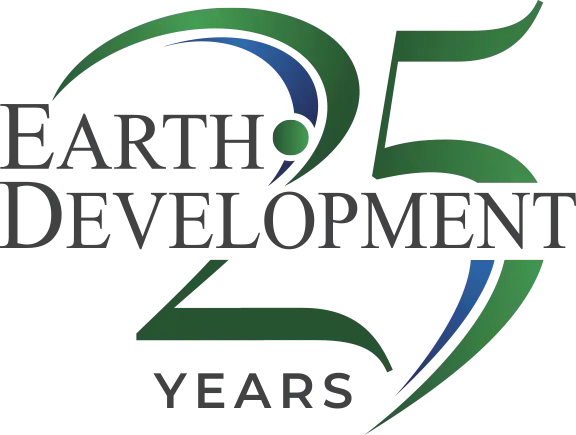Lawn dethatching can be crucial to keeping your grass and soil healthy. Even if you are mowing and doing everything else necessary for your lawn, thatch can build up. Over-watering and over-fertilization can cause excess thatch. Detaching removes the thick layer of dead plant material (thatch). This allows air, water, and nutrients to reach your plants and soil again. Dethatching allows your lawn to drain better as well. By learning why dethatching is important, as well as when and how to dethatch, it will be easier to keep your lawn healthy. Here’s how it’s done.
What Is Thatch?
Before diving into why dethatch lawn spaces, let’s first understand what thatch is.
The term “thatch” refers to a tightly intermingled layer of dead organic matter, as well as living grass shoots, stems, and roots. This thatch layer builds up above the soil but below the green vegetation, creating a built-up area above the soil and grassroots.
While lawn dethatching is an essential aspect of lawn care, a bit of thatch is actually normal and beneficial. This is because:
- It gives a slight bounce to turf, ideal for little feet and golf balls.
- A thin layer can help boost the grass’ resilience to daily wear.
- A thin thatch layer helps insulate the soil and grass roots against extreme temperatures.
This lawn thatch develops as a result of organic matter producing faster than it decomposes in the grass. While a fast-growing lawn is ideal to many, the excessive thatch build-up can cause issues including:
- Creating a home for disease-causing fungi and insects.
- Holding humidity, which promotes disease.
- Limiting root growth, creating a shallow system of grassroots.
- Slows down the movement of air, water, and nutrients in the soil.
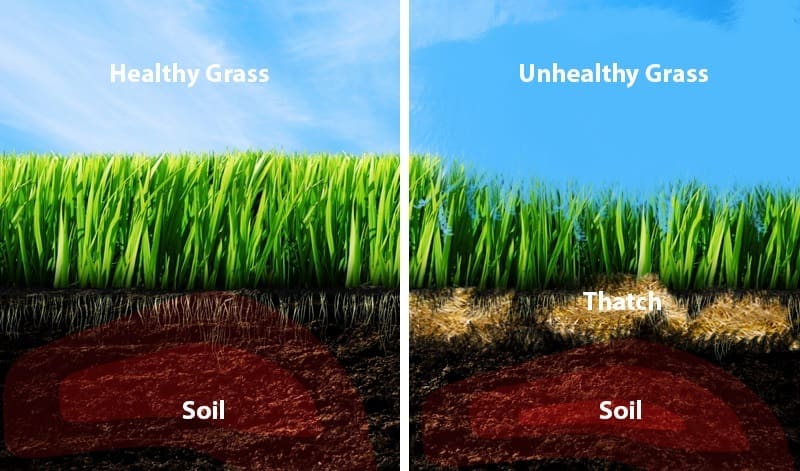
Common Causes of Thatch
There are many factors that can cause a thatch layer to build in your lawn. While some used to think a thick thatch was a result of grass clippings, it actually typically is built up due to various elements, including:
- Dead leaves that decayed, as well as stems and roots.
- Roots growing within the thatch layer without reaching the soil beneath.
- Lateral shoot growth which interferes with roots that are growing down.
- Infrequent mowing. It’s recommended that lawns are mowed weekly during the growing season.
- Mowing off too much at once. It’s best to follow the one-third rule, removing just one-third of the height of the grass per mow.
- Too much water, which causes the soil to become wet resulting in drainage problems. On the other hand, dry soils can create build-up when too dry, keeping water from passing through.
- Pesticides are used when they aren’t needed, ultimately killing earthworms which stimulates thatch breakdown.
- The type of grass. Cool-season grasses such as Kentucky bluegrass, creeping bentgrass, and creeping red fescue can have stem issues that contribute to thatch buildup. Additionally, warm-season grasses that create excess thatch are Bermudagrass, centipedegrass, St. Augustinegrass, and Zoysiagrass.
Signs Your Lawn Needs Dethatching
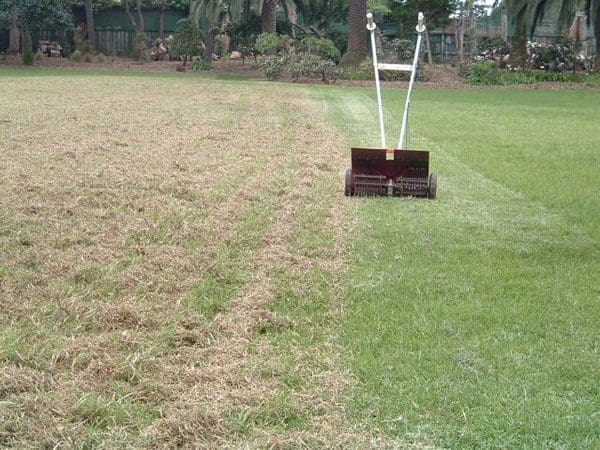
Wondering when to dethatch lawn environments? There are a few ways to tell it’s time to pull out your lawn mower and dethatch your lawn, including:
- The thatch is above a half-inch thick.
- The lawn surface feels bouncy or spongy when walking on it.
- There are noticeable dry spots, signaling the thick thatch is preventing water from reaching the soil surface.
- Footprints take more than an hour to disappear.
- The grass appears to be diseased.
- There are insect problems.
- The lawn isn’t as hardy as it was before.
When to Dethatch a Lawn
Knowing when to dethatch a lawn is essential to ensuring the best results and a healthy lawn.
While it used to be recommended that you dethatch your lawn yearly, there is now a more strategic approach to this lawn service. It’s essential that you do not dethatch your lawn too often, as the deep dethatching rake can tear at grassroots and open up your lawn grass to disease and pest problems. In addition, as previously mentioned, thinner thatch layers can be beneficial to moderating soil temperature, preserving moisture, providing nutrients, and blocking out burrowing pests.
That being said, it’s time to dethatch your lawn when the thatch builds to over 3/4-inch thick. This may only be needed every few years, but being aware of when will make a big difference in the health of your entire lawn. However, when to do this depends on if you are dealing with cool season or warm season grasses.
- Cool Season Grasses: Dethatching is best done when the lawn is growing and the soil is somewhat moist. Typically, cool-season grasses are best to dethatch in early fall or early spring. Especially with Kentucky bluegrass, which is most likely to build thatch, it will be important to monitor your grass for loose thatch.
- Warm Season Grasses: This type of grass is best dethatched when they are growing in the late spring and early summer. It’s best to dethatch these thick thatch layers after you have mowed once. Most commonly, Bermudagrass will need more frequent dethatching than other types, like zoysiagrass.

How to Dethatch a Lawn?
The easy answer on how to dethatch a lawn would be to hire a local lawn care professional. Especially if your thatch is more than 2 inches, hiring a professional might be best. A thick amount of thatch often needs more than one dethatching. If you want to do it yourself there are a few different options and tools. Before you start any of them, it is best to mow your lawn down.
Step 1: Prepare Your Lawn for Dethatching
To prepare for dethatching a lawn, we recommend:
- Dethatching when your soil is moist, but not overly soggy. To prepare your soil layer, water your lawn thoroughly two days before dethatching.
- When using a dethatching machine, mark any shallow irrigation lines, buried utility lines, or sprinkler heads before beginning the process.
- Mow your lawn to half its normal height before dethatching.
- In the case you’re renting a dethatching machine, ask the rental company to adjust the spacing and depth to your specific grass type. You should not cut deeper than 1/2 inch into the soil.
Step 2: Use the Right Tools
To properly dethatch your lawn, there are a number of tools to turn to, including a thatching rake, power rake, vertical mower, and more. Let’s break it down.
Manual Dethatching
For manual dethatching, all you need is a dethatching rake. This method is best for a small amount of thatch on a small lawn.
Power Rakes
Similar to a mower, power rakes dig into thatch at the soil and pull it out. This is also good for a small amount of thatch. You want to be careful as it can be destructive to your grass. It’s best used on strong grass that can take it.
Vertical Mowers
Vertical mowers, like power rakes, pull the thatch up from the soil. They often take grassroots along with it. Vertical mowers are good if you have a thick layer of thatch.
Regardless of what tool you choose to use, there is some aftercare that is necessary. After you finish dethatching, it is important to finish by raking up all the excess thatch on your lawn. Then water and fertilize your lawn thoroughly.
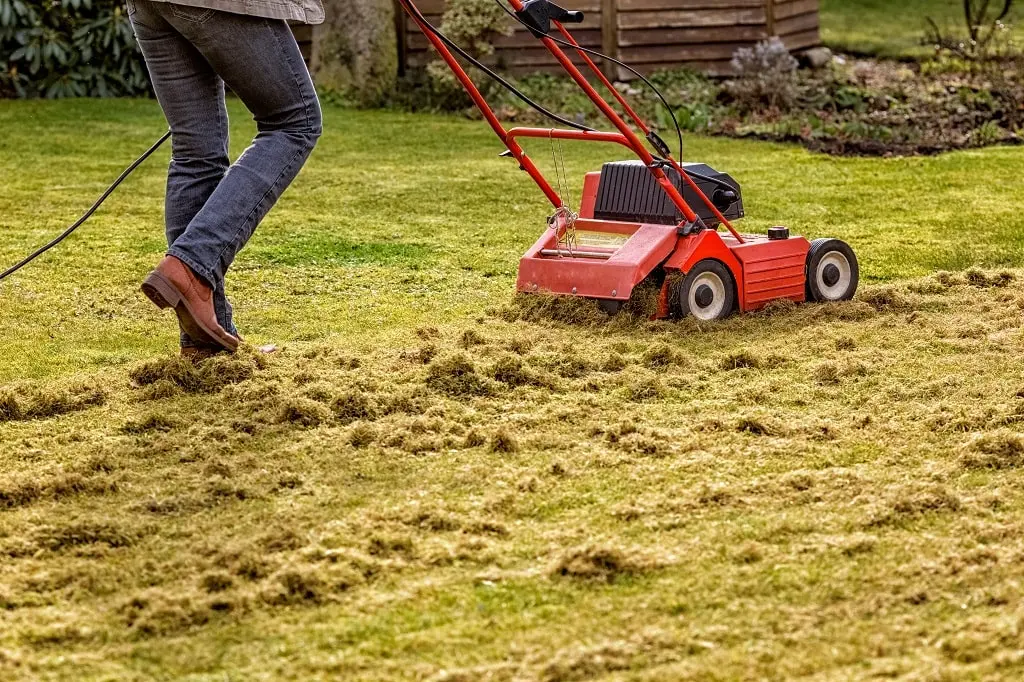
Step 3: Dethatch
Now that you’ve prepared, it’s time to remove the thatch from the grass blades. To address too much thatch, we recommend:
- Dethatching with the proper soil moisture. It’s important that the soil is moist, but now wet.
- Run the dethatching machine at least three times. Be sure to go in different directions each time to properly dethatch your lawn.
- Be sure that the machine is churning up roughly the same volume of material with each pass across the lawn.
- Always remove the piles of thatch immediately after dethatching.
- During this process, it’s best to seed the lawn right away to help fuel new growth.
- Before finishing, consider topdressing. This can help boost your existing root system for a healthier lawn.
Step 4: Don’t Forget about After Care
Don’t panic if your lawn immediately looks worse for wear. No matter what method of dethatching you used, it will take a moment for your entire lawn to look its best again. To boost the process, implement a quality fertilizer and deep watering to your lawn back on its feet and promote a vibrant, resilient finish.
Remember – the dethatching process is quite intricate and is like doing surgery on your lawn. For this reason, it takes a moment for it to recover!
Downsides of Dethatching
Thatch has many beneficial purposes. It only becomes damaging when too much builds up. The right amount of thatch protects your plants from extreme temperatures. It also keeps moisture in the soil and prevents weeds. If you can keep your thatch at a small amount, there is no need to dethatch. The problems discussed above that thatch can cause only becomes an issue when there is too much of it.
If you do need to dethatch, it is important to remember that dethatching can be damaging. Dethatching tears and rips dormant turf. This can affect its ability to recover, especially after a hard winter. Using power equipment to dethatch can bring up weeds. These weeds can then infiltrate your lawn. If you dethatch excessively, or when it is not needed, it will end up causing more harm than good.
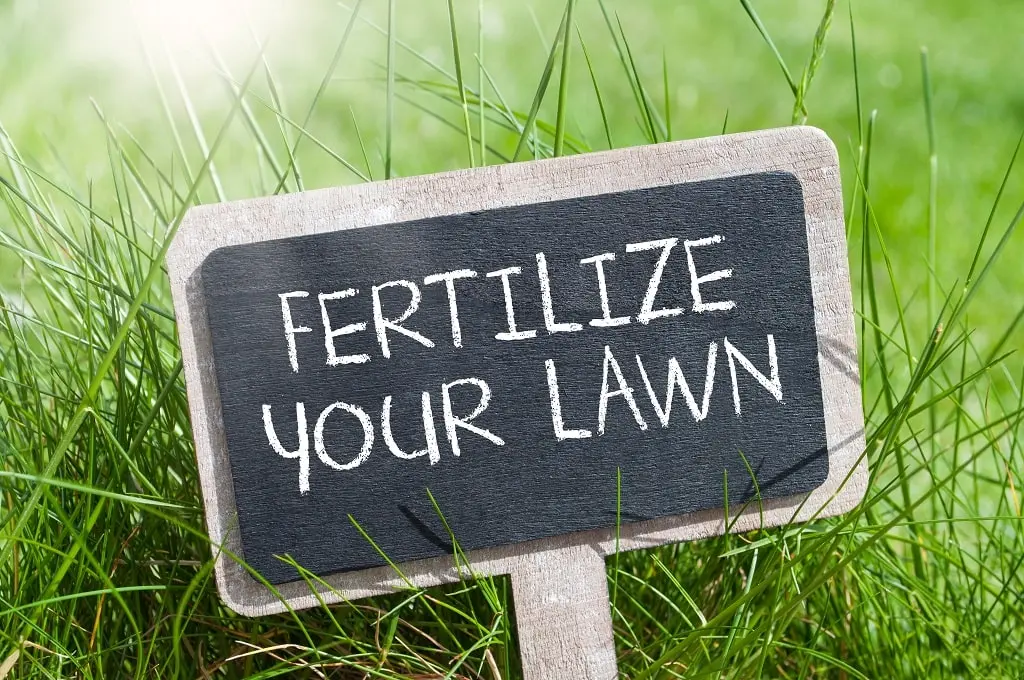
How to Prevent Thatch Buildup
There are ways to prevent that thick thatch layer from building up between grass blades. To boost your lawn health and prevent thatch, we recommend:
- Fertilizing your lawn only enough to maintain the desired growth and color. This is best done in the fall to grow strong roots.
- Aerate the soil to promote proper drainage. In addition, fertilize a week before aerating to boost grass growth.
- Mow properly! Never trim more than one-third of the grass height, and leave the grass clippings to decompose.
- Avoid pesticides unless entirely necessary.
- Test your soil often to check the nutrient levels and acidity, ensuring you manage the pH for a healthy lawn. Keep in mind that too much fertilizer can cause an overproduction of thatch, and testing your soil can help determine if and when fertilizer is needed.
When to Call a Lawn Care Professional?
Whether your lawn is feeling abnormally bouncy, or you can actually see how much thatch has built up on our lawn, it’s time for some general thatch maintenance. With knowledge of everything from cool season lawns, to heavy clay soil, and maintenance of small lawns, our lawn care professionals are proud to offer our lawn dethatching services for a healthier lawn.
As the leading Midwest commercial landscaping contractor, our team at Earth Development can help you make your landscape look good with all types of individualized solutions for lawn cleanup, lawn fertilizing services, and more. Get a free quote online today, or contact us now at (866) 576-78171!
